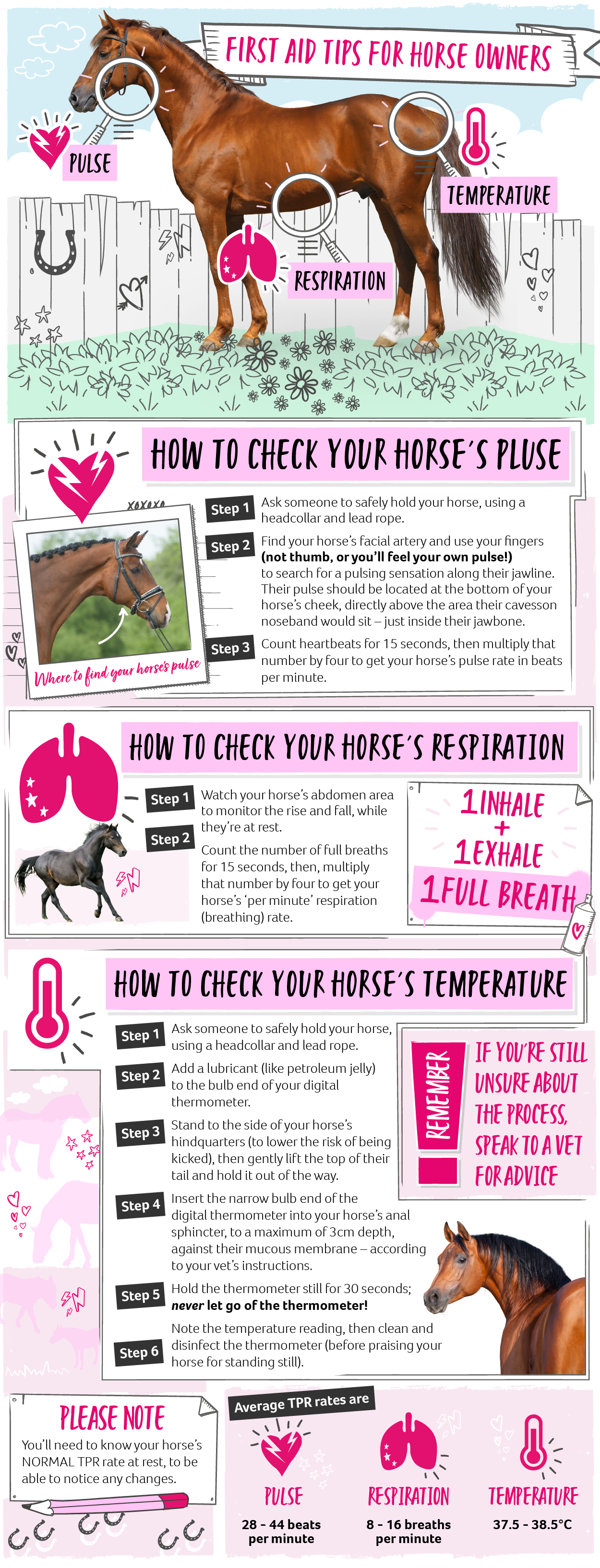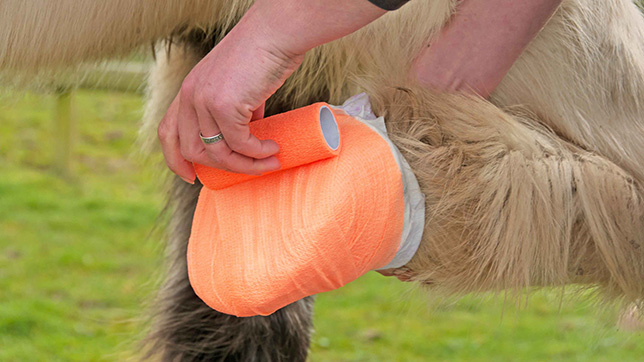28th October 2021
First aid tips for horse owners
Keeping our horses healthy is our top priority. Luckily, there are steps we can take to make sure our equine friends feel fantastic:
- Provide a suitable diet (according to their health, condition, workload, etc.).
- Groom them every day.
- Use correctly fitted rugs and tack (e.g. saddle, bridle, brushing boots, etc.).
- Develop appropriate exercise routines (depending on health, fitness, etc.).
- Allow daily turnout time with field friends (if safe to do so!).
- Keep vaccinations up to date.
- Follow a vet-approved worming programme.
- Book regular farrier appointments.
- Organise six-monthly dental check-ups.
- Arrange yearly saddle checks with a qualified saddle-fitter.
- Record their normal temperature, pulse, and respiration rate while resting.
Here's how to take your horse's temperature, pulse, and respiration rate (TPR):

If in doubt, please ask your vet how to take your horse's TPR safely.
Sometimes, accidents happen, or horses become ill through no fault of our own. As horse owners, we must be prepared to perform first aid in an emergency, because our actions could make enough of a difference to lead to a positive outcome.
The following first aid tips are not a replacement for expert veterinary care or advice. Please speak to your vet before trying any of the following tips on your horse and always contact your vet if your horse has suffered an injury or is showing signs of illness!
First aid kit for horses
You’ll need to store an equine first aid kit in a clean, dry, safe space (out of reach of horses and children!), in at least one of the following, accessible, locations:
- Outside their stable.
- In the tack room.
- In the feed room.
- In the hay barn.
- Near the arena.
- In your horse trailer or horsebox.
Remember: Always take an equine first aid kit when travelling with your horse!
Here are some essential items to have in an equine first aid kit:
- Basic equine first aid guide.
- Disposable gloves.
- Horse-friendly antiseptic/antibacterial/antimicrobial skin solution.
- Large, non-fleecing, horse-friendly cotton wool roll.
- Sterile, non-stick wound dressings.
- Self-adhesive bandaging wraps.
- Poultice materials.
- Silver tape (for securing hoof poultices).
- Cleansing wipes.
- Wound gel.
- Scissors.
- Tweezers.
- Thermometer.
- Small pot of petroleum jelly.
Many horse owners also add extra items to their horses’ first aid kits!
In case someone else has to take care of your horse in an emergency, it’s important to include the following in your horse’s first aid kit:
- Vet’s contact information.
- Your contact information.
- Emergency procedure (e.g. who makes decisions for your horse’s welfare in an emergency, if you can’t be contacted?).
We suggest keeping human first aid kits in safe spaces around the livery yard, too. Be sure that they are clearly labelled though, to avoid any confusion.
Discover our first aid advice, to help you care for your horse safely while waiting for a vet...
Wounds
Call your vet if your horse has an injury.
There are different types of wounds:
- Puncture wounds – usually happen when pierced with an object, like a nail. Puncture wounds can be extremely serious (despite their small size) because they can be deeper than they appear and have a huge risk of infection. If on a joint, do not poultice a puncture wound as this will draw out synovial (joint) fluid. Always call a vet to assess a puncture wound before treating it!
- Incised wounds – tend to bleed a lot and are usually caused by sharp objects, like broken metal gates. Incised wounds can appear to be a smooth slice, yet they’re often deeper than they seem to be. It’s important to call your vet straight away if your horse has a clean-cut wound.
- Lacerated wounds – can be the result of getting tangled with tough objects, like barbed wire. As well as having jagged (uneven) edges, lacerated wounds that have torn a horse’s skin can also cause a lot of swelling. Again, your vet will need to be called before you attempt to treat a laceration.
- Abrasion wounds – are surface scratches that are often accompanied by swelling or bruising. Although they seem minor, abrasions can take a long time to get better and will require veterinary advice to treat properly.
Treating wounds
While waiting for the vet, you’ll need to:
Step 1 – Assess the injury to work out the type of wound.
Step 2 – Stop the bleeding, if you can, following your vet’s advice.
Step 3 – Gently clean the affected area, if advised by your vet, by cold hosing the area around the wound.
Step 4 – Prevent infection by covering the wound using appropriate bandaging techniques, as directed by your vet.
Lameness
Lameness can be a tricky issue for horse owners. While some horses will be extremely lame and let their owners know exactly what’s wrong, other horses are more subtle and make it tough for us to find the root of the problem.
You can gently check your horse’s lower legs and hooves for any heat, swelling, wounds, or other signs of injury.
Have an experienced handler lead your horse on a flat, hard surface so you can watch how they walk and trot. Signs of lameness in horses:
- Uneven gait (e.g. their hip dips more on one side as they trot away from you).
- Head nodding (e.g. front leg lameness sometimes causes horses to raise their head as the hoof of their painful leg hits the ground).
- Obvious signs of discomfort (e.g. they are reluctant to move forwards).
Although your vet will give advice about how to treat lameness, if you spot swelling or heat in your horse’s lower legs, cold hosing for a few minutes can help to temporarily ease their discomfort.
There are countless causes of lameness in horses, so the best way to diagnose your horse’s lameness is to have them checked by your vet.
If your horse shows any sign of lameness or discomfort, please contact your vet as soon as possible!
Hoof abscesses
A hoof abscess develops when bacteria enters the hoof (usually due to a sharp object, like a nail) and a build-up of pus within the hoof causes considerable pain.
Horses who have a hoof abscess will suddenly become lame and will appear to ‘hop’ or may refuse to put weight on their painful hoof.
The treatment for a hoof abscess tends to involve complete box rest and using hoof poultices that are changed every day, until all the pus has drained from your horse’s hoof.
Contact your vet if you think your horse has a hoof abscess!

Laminitis
Any horse can get laminitis at any time of year.
Laminitis is a painful condition affecting the sensitive laminae of a horse’s hoof.
Sensitive laminae hold your horse’s pedal bone (in the hoof) in place, though laminitis causes the sensitive laminae to get weaker, which results in movement of the pedal bone.
Although most cases of laminitis are linked to hormonal conditions (like Cushing’s disease or EMS) or to weight gain, other cases can be caused by stress or lower leg injuries.
The characteristic stance of a horse with laminitis strikes fear into the heart of horse owners across the world. Many horses suffering from laminitis will rock back on their hind legs to take weight off their front hooves – at first, this could be confused for a strange sort of stretch.
However, some horses may not show obvious signs of laminitis.
Any signs of laminitis, or other lameness, in your horse should be investigated urgently by a vet.
Contagious illnesses
It is our responsibility to protect our equine friends from catching contagious diseases.
Some of the steps you can take to prevent spreading equine illnesses include:
- Getting your horse vaccinated.
- Isolating new horses for a few weeks, in a stable away from the main stable block(s), before introducing them to horses already living at your livery yard.
- Having separate grooming equipment and mucking-out tools for each horse.
- Cleaning food and water buckets every day.
- Keeping tack, rugs, and other equipment clean.
- Frequently wash your hands, especially when handling different horses.
- Washing your boots before moving from one stable to another.
- Ensuring your horse doesn’t have direct contact with neighbouring horses.
Ask your vet’s advice about ensuring there’s good biosecurity in place at your horse’s livery yard.
Equine flu
Prevention is important in the fight against flu, so having your horse vaccinated every year will decrease the chances of them catching equine flu.
Symptoms of equine flu:
- Increased temperature.
- Cough.
- Loss of appetite.
- Lethargy.
- Nasal discharge (starts thin and clear but becomes thick and yellow).
Always call an equine vet if your horse shows signs of flu!
Strangles
Strangles is a life-threatening, highly contagious disease.
Symptoms of strangles include:
- High temperature.
- Depression.
- Difficulty swallowing.
- Lowered head and neck.
- Coughing.
- Thick nasal discharge.
- Swelling of glands under their jaw or around their head/neck.
- Abscesses under their jaw.
If you suspect your horse has caught strangles, whether they’re showing symptoms or not, contact your vet immediately and isolate your horse from the rest of the yard.
Treatment of strangles will rely on veterinary advice, though it’s important you let the owners of other horses your equine friend may have been in contact with know what’s happened, so they can take steps to prevent the spread of strangles.
Choke
Horses suffer choke when there’s a blockage of the gullet (a tube passing food from mouth to stomach).
It’s important to stay calm and call a vet if you think your horse may have choke.
For more information about dealing with choke, visit our article about coughing in horses.
Colic
Should you notice any of the following symptoms of colic in your horse, contact your vet straight away:
- Restlessness.
- Pawing.
- Kicking their own stomach.
- Repeatedly lying down and getting up.
- Urgent rolling.
- Circling.
- Box walking.
- Excessive or unexplained sweating.
- Sudden loss of appetite.
- Tense stomach muscles (or they look ‘tucked up’).
- Passing few droppings or no droppings.
- Consistency of droppings changes.
- Head position is lowered.
- Depressed demeanour.
- Rapid breathing.
- Minimal gut sounds or no gut sounds at all.
Find out exactly what to do if your horse has colic, by visiting our article all about colic in horses.
Looking for more horse advice?
Support and advice so that owners and riders can take the very best care of their equine.
Need horse insurance?
Horse insurance can help cover the cost of veterinary treatment if your horse gets injured or falls ill.
We know pets
Our pets are part of the family. To achieve our vision of a better future for pets everywhere, we work with our partners, vets, and other veterinary professionals who are pioneering the latest advancements in animal care. Our campaigns, articles, and events are crafted to support, educate, and celebrate pet owners, while our policies are designed to provide peace of mind at an affordable price.
Yet our policies don’t just protect against the unexpected – they have purpose, too.
Since we were founded over 25 years ago, we've provided industry-leading policies that protect the nation’s pets, while also making a difference to animal welfare and our planet. Thanks to you, our policyholders, we've donated over £9 million to more than 830 animal welfare charities and conservancies, helping to support vulnerable pets and wildlife around the world.
We’re proud to be wildly different. Are you?
